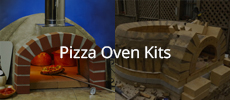Hi Guys, I ask your opinion on one of the most difficult part of this journey: the arch.
I already tapered all the bricks and read a lot of theory, but now I’m a little bit stuck .
In order to be aligned with the dome courses, should I:
1) cut the arch bricks in order to be aligned with the 4th course (red line) , but leaving smaller bricks for the arch
2) be aligned with the 5th course, a bit prominent inside the dome but less work and bigger bricks ?
thanks for your opinion
Announcement
Collapse
No announcement yet.
DANTE - 36" (92cm) Pompei oven - Luxembourg / Italy
Collapse
X
-
you could use an online calculator, like this one: https://www.blocklayer.com/masonry-arch.aspx
But it's not so hard to do it yourself:
You first need to know how many bricks you will need, you want as few as possible, but you also want to keep the joints nice and thin.
You should realise that the dimensions at the top of the bricks are proportional to the ones at the bottom (see attached illustration)
R1/R2 = L1/L2
So, in practice:
1. You know your arch radius (R1). To know the radius of the top of the arch R2, just add your brick height. Use a flexible measure on your entry shape to determine the length of the arch (L1). Now, the length of the top arch can be calculated using that ratio:
L2 = L1 * R2 / R1.
2. Now that you know L2 (in my case it was 755mm), you can determine how many bricks you will need: My bricks were 55mm wide, and I wanted the joints to be around 5mm. Together that's 60mm. Dividing L2 by that number and rounding up to the nearest integer number (or to the nearest odd integer number if you insist on a central keystone). In my case, the result of the division was 12.58, so I decided for 13 arch stones.
N = L2 / (brick_width + joint) rounded to nearest (odd) integer
3. Now that you know how many bricks there will be, you can divide the arch lengths to find the individual brick widths:
W2 = (L2 / N) - joint
W1 = (L1 / N) - joint
1 Photo
Leave a comment:
-
Hello Guys, having some confidence problems approaching the 5th course and the arch.
I honestly don’t understand how to calculate the right angle to Bevel a bricks and all the step in order to avoid inverted V.
I’m on holiday and I’d like to prepare a list of the cutting course by course , In order not to improvising too much.
Second issue is about the arch, I understand how to lay the bricks but no idea on how to cut them on the long side (8”).
Any help would be really appreciated
Leave a comment:
-
I’m fixing the IT board as soon as the first course is sufficiently dry and cleaned ( lot of mortar went on the floor lately )Originally posted by Kvanbael View PostCool! It has begun.
You might want to fixate your IT with more than tape and weights. But you are probably waiting for your first course to be fully set before doing so.
Leave a comment:
-
Cool! It has begun.
You might want to fixate your IT with more than tape and weights. But you are probably waiting for your first course to be fully set before doing so.
- Likes 1
Leave a comment:
-
Yesterday afternoon I started laying the floor and the first course.
Many emotions in that moment, I hated but I loved it !
I used an Italian refractory mortar and follow the ratio written on the bags, small batch of 1 kg each is perfect for laying around 4-5 bricks ( put bricks in water 1 hour before) .
I finished around 9pm and this morning at 10 was already there, completing the 2nd course .
Now I’m approaching the entry arch
- Likes 1
Leave a comment:
-
I honestly don’t know because vermicrete is not absorbing water as the calcium silicate boards, if the concrete hearth is flat and leveled you don’t have to worry about any water stagnation under the oven. But you can find many solutions on this forum
Leave a comment:
-
I didn't add any weep holes to my hearth. I did a 3 inch layer of reinforced concrete with 4 inches of insulating perlite-concrete on top. I have my dome and chimney about done and the dome insulation. Would it be wise to drill some weep holes into the side of my hearth insulating layer before finishing off with face brick? I didn't use the calcium silicate boards, so I don't need to worry about those getting water logged.
Leave a comment:
-
The aluminum foil layer seems to have been resurfacing again recently on several builds. I guess the school of thought is some sort of water resistant layer. It goes both ways, Water that gets in also gets trapped limiting egress out. IMHO, I do not think aluminum foil provides any value to the build.
Leave a comment:
-
Yesterday the calcium silicate boards arrived and today I today I put them on the hearth, covered with aluminum foil and on top some tiles. After that, I pour the perlite/concrete layer, about 4 cm
Leave a comment:
-
Weep holes in hearth is recommended, raising CaSi off hearth with scrap ceramic tiles is being used a lot lately, 50/50 sand/clay between CaSi and firebrick floor for leveling if need (not more the 1/4-1/2" typically needed).
Leave a comment:
-
UtahBeehiver Thank you! I’ve just hand cut in half around 60 bricks to do the first 3 courses and then I’ll taper the next ones, and close to the end I’ll cut the bricks in 3. ( thanks Kvanbael).
Just one reminder : concrete hearth, CaSil boards 5cm and refractory floor... do I need to put something in between the layers ?
Leave a comment:
-
As you move up in courses and the dome diameter decreases, unless you bevel the bricks you will start to see what we call an "inverted v" mortar joint. This can be reduced by beveling the top inner corners of the bricks either with a grinder or wet saw. You only need to remove the conflicting material, typically a inch or so back from the top inner corners of the bricks. JR Pizza did this, I did full taper and bevels but that takes time.
Leave a comment:
-
It looks good! I couldn't get my bricks to get much tighter than that. They opened up a bit doing the dome, so I hope the gaps won't be a problem. I don't know if it is wise to fill in the gaps with the silica/fireclay or mortar or just leave them alone. I could use some wisdom on that too!
Are your bricks refractory/fire brick or insulating brick? The low to medium-duty refractory bricks are pretty easy to cut with an angle grinder or wet saw, but insulating bricks are super easy and can be cut with a hand saw.
Leave a comment:





Leave a comment: